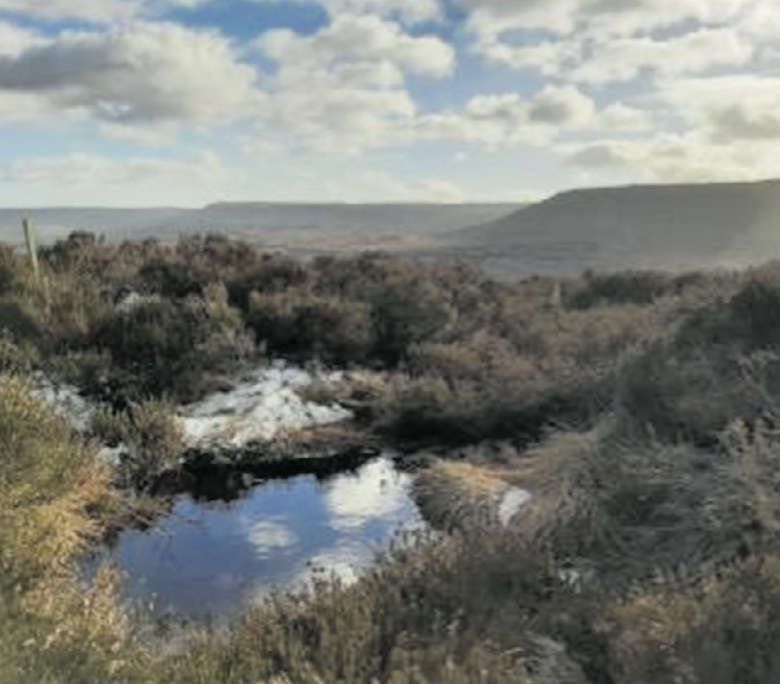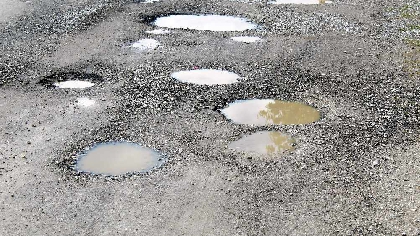
A team of researchers at the University of Manchester has won a government grant to trial new methods of restoring peatlands in the hills above Glossop.
While peatland restoration has been under way across Bleaklow and Kinder for some years, the new trials will look at increasing the amount of greenhouse gasses which can be stored in the peat, as well as bringing back the sphagnum mosses which had been killed off by years of acid rain.
When in good condition, peatlands - such as the heather moors surrounding Glossop - can store millions of tons of carbon dioxide and help fight climate change.
After years of acid rain from the industrial revolution, however, many of the Peak District's peatland areas have become degraded, meaning they are releasing carbon to the atmosphere.
Where plants have died back and bare peat has been exposed, gullies have formed which means instead of releasing rainwater slowly, water is quickly transported downstream, posing a flood risk for local communities.
The restoration project will be blocking up the gullies which have formed and reintroducing sphagnum mosses to get the peatlands back into their climate and flood alleviating condition.
A new aspect of this project will be trying to unlock carbon credits so that local farmers, gamekeepers and land owners can be paid for getting the peat into the carbon sequestering conditions.
The Manchester University team will do this by mowing heather then using it to make charcoal which can lock up carbon, as an alternative to heather burning which is used to help support the grouse on the moor.
If this works then landowners in the area could be paid to store carbon while keeping the land in its current use as sheep grazing and grouse moor.
Often, when peatland areas are restored, they can start to release methane as the soil becomes waterlogged. This is a problem as methane is an even more powerful greenhouse gas than carbon dioxide, so the team is also looking at ways of making sure this doesn't happen.
One way of doing this by reintroducing sphagnum mosses to the area. When they get established, sphagnum mosses can form a carpet over the boggy peat which traps the methane and allows bacteria time to consume the methane as an energy source, converting it into carbon dioxide.
As the mosses also increase biodiversity and are very good at storing carbon, they're seen as a win-win for peatlands and the climate. Over the coming months, more than 36,000 sphagnum moss plugs will be planted on the moors.
Dr Jonny Ritson, who works on the project and lives in Glossop, has been setting up monitoring sites in the area to track how much carbon the peat is storing and how quickly the mosses are coming back.
"We think this is going to be a really important project for how much of Peak District is managed in years to come," Dr Ritson said.
"If we can get it right, it provides the opportunity for farmers to receive funding to manage the peat in ways that will lower flood risk to Glossop as well as helping the country meet its climate change targets."
The government has stated that restoring peatlands will be a key part of its strategy to reach net zero climate emissions by 2050.
If this project is successful, it is hoped that the extra money available to farmers will accelerate the rate of peatland restoration in the area.
The restoration will take place over the next four years and is part of a wider series of projects across the UK, which the government is funding to see how much carbon can be sequestered by restoring peatlands, planting trees and storing carbon in charcoal.
Each part of this could be vital to help the UK meet its climate targets.
The Peak District project above Glossop has been supported by Natural England and The National Trust and will be ongoing for the next four years.
So, if anyone see some unusual scientific equipment while walking on the moors, please leave it as you found it!
Read more from the Glossop Chronicle
Click here for more of the latest news
Click here to read the latest edition of the paper online
Click here to find out where you can pick up a copy of the paper


 Charity match raises £5,000 for Reuben's Retreat
Charity match raises £5,000 for Reuben's Retreat
 Glossop dad and daughter duo take to the sky to raise money for local dance school
Glossop dad and daughter duo take to the sky to raise money for local dance school
 New headteacher appointed at St Philip Howard Catholic Voluntary Academy
New headteacher appointed at St Philip Howard Catholic Voluntary Academy
 How to avoid potholes and what to do if you hit one, according to experts
How to avoid potholes and what to do if you hit one, according to experts



